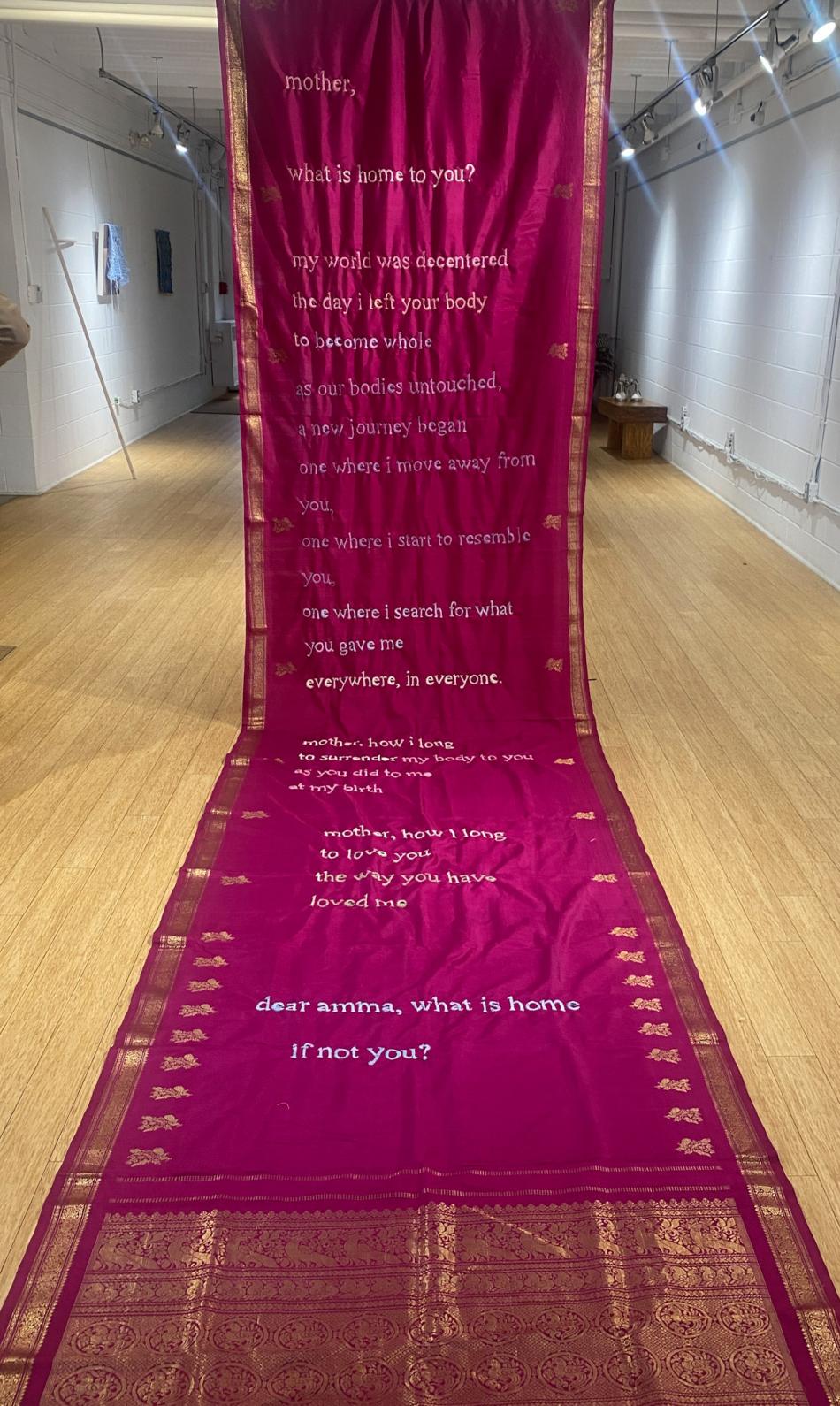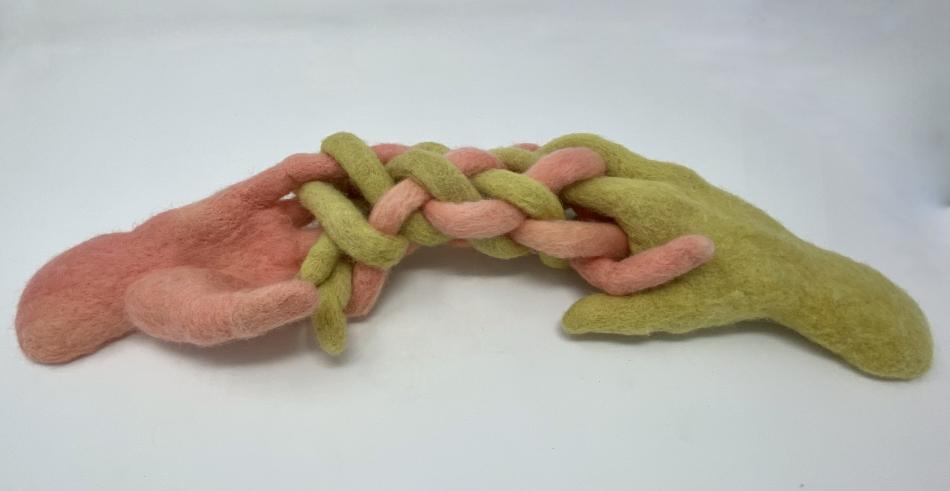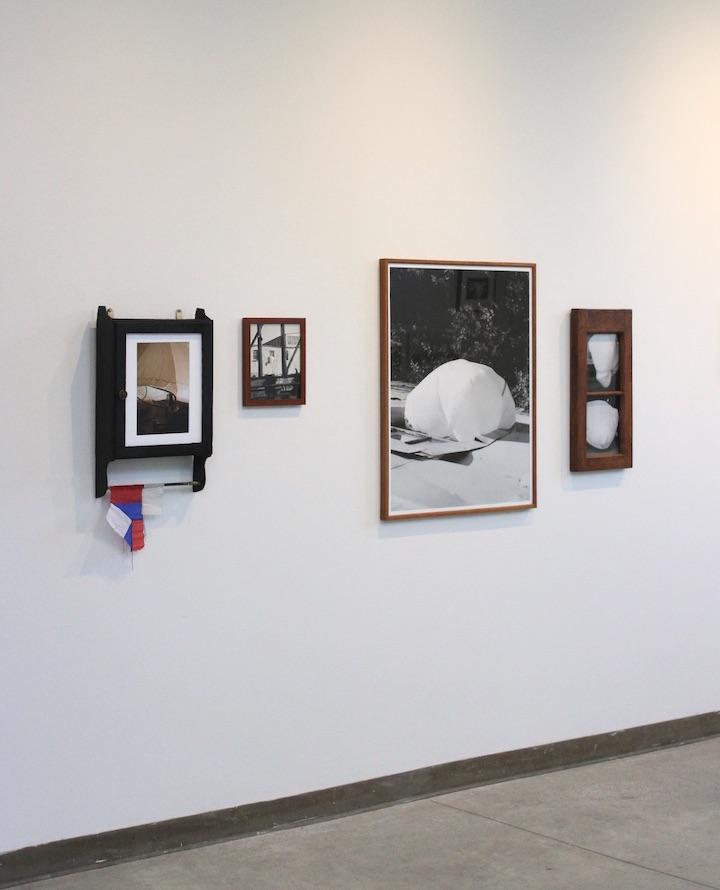Bodies are complicated but integral subjects in contemporary art. The body is a conduit for narratives that traverse the physical and social landscape. We live in times where the political body has never been more precariously placed. Member artists Laura Honsberger, Alana Morouney, and Par Nair gesture to the presence (or absence) of bodies in their practices and comment on the discourse of the body in contemporary times. Elaborations on topics of care, harm, healing, and embodiment are explored in this interdisciplinary exhibition.
to feel at home in my clothed body
Bianca Isabel Garcia
When flesh touches fabric, a homely kind of magic materializes. Our clothes bear witness to our lived experiences, and they hold bodily memories in wrinkles (sitting down), tears and rips (threads stretching past their limit), stains (sweat permeating fabric), and other marks of wear.
No one knows us like our “dirty” clothes do.
As much as we might feel at ease and at home in our clothed bodies, garments can also invite unease and fear, because we fashion our bodies for a social world built on the violence of labour exploitation and colonial systems of erasure. Inhabiting this uneasy experience can also mean home. What does the relationship between the body and clothing look like when there is (no)body at all? Textile-based rituals guide abstract explorations of the body for artists Alana Morouney, Laura Honsberger, and Par Nair, who stitch together past memories and new realities of home in (no)body.
(a note on rituals)
A ritual is a practice or habit that involves intention, attention, and repetition. It does not have to be tied to a religious, spiritual, or cultural practice. A ritual offers a place of healing where you can process and detangle knots of heavy emotions. It opens a portal of connection to past, present, and future versions of yourself and your community.
I acknowledge and adapt to my current bodily reality
In this exhibit, I see artists acknowledge the inevitability of specific realities that inflict pain or difficult change upon their bodies as they learn rituals of adaptation for living with those realities. A photographic archive that testifies to the physical impact of years working in the labour-intensive garment manufacturing industry, in my dreams I’m dancing & I feel no pain (2022), holds expansive imaginative space to both document and reconstruct Laura Honsberger’s bodily memories of psoriatic arthritis and physical textile labour.
The stage is set at a garment manufacturer, home to Laura’s workplace. Here, you’ll see a curious bulging presence sewn with ripstop—a woven fabric specifically produced to resist rips and tears. The artist’s choice of soft yet unyielding cloth to reconstruct the inflatable inflammation resonates with the unpredictable tenacity of psoriatic arthritis. In Apo-Naproxen (2022), it bursts forth from windows refusing to be contained. In Diclofenac (2022), it drifts like a subdued thundercloud through the garage, a storm approaching. Its buoyancy is not to be confused with gentleness; the disembodied bulge is erratic and requires repeated rituals of treatment. Laura points to this bodily adaptation by naming photographs after anti-inflammatory medications. Laura beckons you further into her home with Drain (2022), where a bathroom medicine cabinet displays a patchwork ripstop quilt assembled with unfinished edges and sharp, unforgiving shapes. These shapes acknowledge the physical reality of pain as Laura continues to creatively engage in repetitive rituals that guide coexistence with pain as part of her past, her future, her body, her home.
Where in my dreams I’m dancing & I feel no pain (2022) explores textile-based responses to bodily constriction and pain, Alana Morouney uses textiles for the purpose of nurturing her child’s wellbeing, integratingrituals of play into her work. In mother/child/marigold/flower (2023), the mother is “the man behind the curtain,” but unlike the wizard, she lets the child in on the trick the whole time. The delight is not in the deception. Crossed arms of marigold dye and needle-felted wool emerge from underneath the curtain in plain view. Defying reality, the mother’s fingers contort themselves in impossible curved shapes—I dare you to try this pose with your own hands. She grows an extraneous two fingers on each hand, a mischievous embodiment and testament to the lengths her body and mind can reach, to perform acts of love and care for a beloved child. The two-dimensional shadow stem (created with ink brushed onto the curtain) extends long above the “human” arms and bursts into a towering flower with round petals, mimicking and heightening the spellbinding, curved fingers.
How could a child not be enchanted? This is pure world creation, an everyday magic that happens at home atop wrinkled cotton sheets. I can imagine a nighttime ritual of shadow puppet shows, and a child who never ceases to be amazed—rather nourished in love and imagination.
I touch and untouch. I stitch and unstitch the past and the future.
On the other end of a mother’s love you’ll find a child reaching back. Draped high on the wall like tapestries, Par Nair’s sarees that belong to her mother are meticulously hand embroidered with “letters of haunting.” When I read these letters addressed to amma/mother, the embroidery thread changes colour as the saree fabric naturally wrinkles and folds, evoking sunlight on water. As vibrant matter, the hand-embroidered sarees are alive with kaleidoscopic fragments of memory-visions from a child and mother’s relationship. They glimmer together, then apart, and together again. Similar to needle felting, this painstaking embroidery labour reminds me of Alana Morouney’s Knotwork (2021), a whimsical needle-felted (in)human sculpture that drew out of me a childlike impulse to treat it like a game. I wondered: can my eyes follow the plait without losing focus in the infinite loops? The soft rhythm in its hand-held plait feels like the gentle but firm touch of a mother. When the child nourished on shadow puppet shows grows up, I wonder if they will confess the same words that Par Nair embroiders on Stitching In Your Shape (2023):

Stitching In Your Shape (2023) makes me feel the diasporic reality that sometimes feeling at home in your body can mean feeling longing. Like the repetitive puncture of an embroidery or felting needle, I constantly breathe in and out anger about my own geographical, familial, and language separation due to colonial histories.
The textile-based rituals in (no)body embody the act of stitching together that which has been separated, and the newness that emerges. Movement apart, movement together again.
I rip apart and return, each cycle anew.
About the Artists
Laura Honsberger is a visual artist who works with textiles, photography, and assemblage. Honsberger’s practice works as a method to process memories and to communicate their impressions that remain in the mind and body. She recreates memories with materials, stages scenes, and uses photography to document the recreations. Her current work considers how a body adapts to and is formed by constriction and pain. Her practice is heavily influenced by working in the garment manufacturing industry and its labour-intensive methods of production. Queerness is a common thread through Honsberger’s concepts and use of materials.
Alana Morouney (she/they) is a bilingual textile artist and metal sculptor in Mi’kma’ki/Sackville, New Brunswick. Using simple mechanics and materials that draw the hand, herinteractive sculptures deliver unexpectedly pleasant outcomes. Working in a small studio open to the sounds of the house, the play of children travels unimpeded to her desk and becomes part of her work. While seeking out gentle daydreams and moments of stillness, the physically repetitive motions of weaving, knitting and sewing become meditative. Familiar materials and mediums clothe subtext with tenderness as tensions are remade as gestures of affection. Alana has given workshops and artist talks in participation with A Handmade Assembly and the Owens Art Gallery Maker Maker series, and was the New Brunswick recipient of the BMO 1st award in 2021. You can find more of her work at alanamorouney.com.
Par Nair (she/her) is an Indian born interdisciplinary artist and researcher who lives and makes in the GTA. Her practice which centers oil paintings, embroidery, installation, performative work and creative writing focus on dual identities, hybrid cultures and fragmented realities of migrants. Par has recently acquired her Master’s in Interdisciplinary Art, Media and Design from OCAD University. Her works have been shown at Mayten’s Gallery (Toronto), Project Casa (Montreal), The Public Gallery (Toronto), Neilson Creative Centre (Etobicoke), Riverdale Art Gallery(Toronto), Propeller Art gallery (Toronto) and The Kochi Biennale (India). Par is the recipient of the Ontario Graduate Scholarship (2021-22), The Career Launcher Prize (2022) and Propeller Gallery’s Emerging Artist Award (2020). Par’s work celebrates the often invisible, misrepresented, and stereotyped voices and stories of Indian women.
Bianca Isabel Garcia is a Toronto-based fashion researcher and creative writer studying Philippine history and US empire. As an artist in the weaving collective habi habi po, Bianca finds purpose in learning and sharing Philippine textile knowledge through collaborative creation. Her writing was featured in Border Garments: Fashion, Feminisms, and Disobedience, a Fashion Studies Journal Special Issue (2023), and her scrap fabric sculptural art BAGYO: Text(ile) Parol and Terno Prototype (2023) was exhibited at Patuloy ang Laban: Legacies of Filipino Activism. In addition to organizing art-based events such as drag shows, protests, and Filipino fashion shows, Bianca also teaches creative mending techniques during w.a.s.t.e.’s “From Here to Wear” slow fashion community programming at East End Arts. Bianca holds a MA in Fashion from Toronto Metropolitan University. You can find her at biancaisabelgarcia.com or on Instagram @bianca.isabel_


